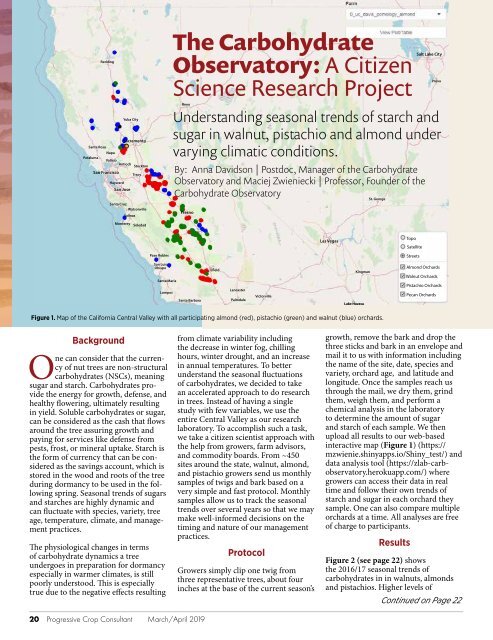PCC March 2019
You also want an ePaper? Increase the reach of your titles
YUMPU automatically turns print PDFs into web optimized ePapers that Google loves.
Santa Rosa<br />
Petaluma<br />
Redding<br />
Napa<br />
Yuba City<br />
Sacramento<br />
Vallejo<br />
Antioch Stockton<br />
San Francisco<br />
Hayward<br />
San Jose<br />
Tracy<br />
Santa Cruz<br />
Watsonville<br />
Salinas<br />
The Carbohydrate<br />
Observatory: A Citizen<br />
Science Research Project<br />
Reno<br />
Fresno<br />
St. George<br />
Salt Lake City<br />
Understanding seasonal trends of starch and<br />
sugar in walnut, pistachio and almond under<br />
varying climatic conditions.<br />
By: Anna Davidson | Postdoc, Manager of the Carbohydrate<br />
Observatory and Maciej Zwieniecki | Professor, Founder of the<br />
Carbohydrate Observatory<br />
Provo<br />
Las Vegas<br />
Topo<br />
Satellite<br />
Monterey Soledad<br />
Paso Robles<br />
Streets<br />
San Luis<br />
Obispo<br />
Santa Maria<br />
Lompoc<br />
Santa Barbara<br />
rsfield<br />
Lancaster<br />
Palmdale<br />
Victorville<br />
Kingman<br />
Lake Havasu<br />
Almond Orchards<br />
Walnut Orchards<br />
Pistachio Orchards<br />
Pecan Orchards<br />
Figure 1. Map of the California Central Valley with all participating almond (red), pistachio (green) and walnut (blue) orchards.<br />
Background<br />
One can consider that the currency<br />
of nut trees are non-structural<br />
carbohydrates (NSCs), meaning<br />
sugar and starch. Carbohydrates provide<br />
the energy for growth, defense, and<br />
healthy flowering, ultimately resulting<br />
in yield. Soluble carbohydrates or sugar,<br />
can be considered as the cash that flows<br />
around the tree assuring growth and<br />
paying for services like defense from<br />
pests, frost, or mineral uptake. Starch is<br />
the form of currency that can be considered<br />
as the savings account, which is<br />
stored in the wood and roots of the tree<br />
during dormancy to be used in the following<br />
spring. Seasonal trends of sugars<br />
and starches are highly dynamic and<br />
can fluctuate with species, variety, tree<br />
age, temperature, climate, and management<br />
practices.<br />
The physiological changes in terms<br />
of carbohydrate dynamics a tree<br />
undergoes in preparation for dormancy<br />
especially in warmer climates, is still<br />
poorly understood. This is especially<br />
true due to the negative effects resulting<br />
from climate variability including<br />
the decrease in winter fog, chilling<br />
hours, winter drought, and an increase<br />
in annual temperatures. To better<br />
understand the seasonal fluctuations<br />
of carbohydrates, we decided to take<br />
an accelerated approach to do research<br />
in trees. Instead of having a single<br />
study with few variables, we use the<br />
entire Central Valley as our research<br />
laboratory. To accomplish such a task,<br />
we take a citizen scientist approach with<br />
the help from growers, farm advisors,<br />
and commodity boards. From ~450<br />
sites around the state, walnut, almond,<br />
and pistachio growers send us monthly<br />
samples of twigs and bark based on a<br />
very simple and fast protocol. Monthly<br />
samples allow us to track the seasonal<br />
trends over several years so that we may<br />
make well-informed decisions on the<br />
timing and nature of our management<br />
practices.<br />
Protocol<br />
Growers simply clip one twig from<br />
three representative trees, about four<br />
inches at the base of the current season’s<br />
growth, remove the bark and drop the<br />
three sticks and bark in an envelope and<br />
mail it to us with information including<br />
the name of the site, date, species and<br />
variety, orchard age, and latitude and<br />
longitude. Once the samples reach us<br />
through the mail, we dry them, grind<br />
them, weigh them, and perform a<br />
chemical analysis in the laboratory<br />
to determine the amount of sugar<br />
and starch of each sample. We then<br />
upload all results to our web-based<br />
interactive map (Figure 1) (https://<br />
mzwienie.shinyapps.io/Shiny_test/) and<br />
data analysis tool (https://zlab-carbobservatory.herokuapp.com/)<br />
where<br />
growers can access their data in real<br />
time and follow their own trends of<br />
starch and sugar in each orchard they<br />
sample. One can also compare multiple<br />
orchards at a time. All analyses are free<br />
of charge to participants.<br />
Results<br />
Figure 2 (see page 22) shows<br />
the 2016/17 seasonal trends of<br />
carbohydrates in in walnuts, almonds<br />
and pistachios. Higher levels of<br />
Continued on Page 22<br />
20 Progressive Crop Consultant <strong>March</strong>/April <strong>2019</strong>


















